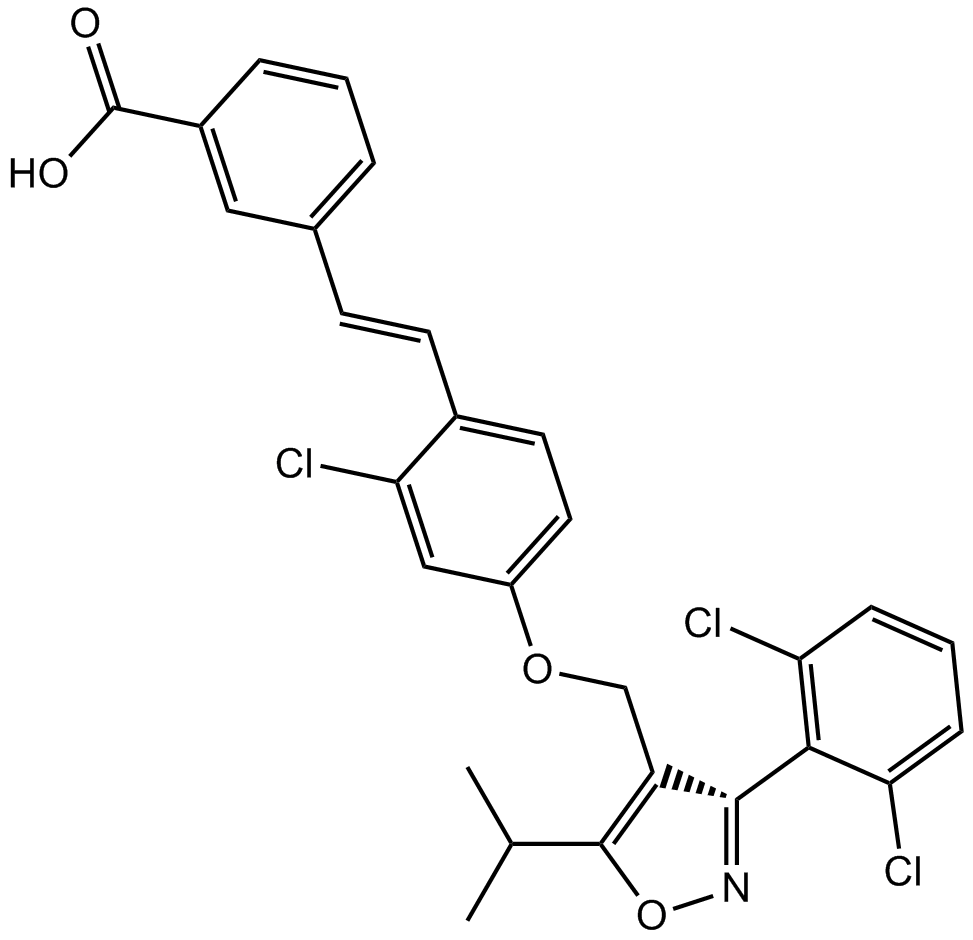GW4064 |
| Catalog No.GC10975 |
GW4064, as a synthetic FXR agonist, was used for treatment of cholestatic liver diseases, metabolic syndrome and alcoholic liver disease.
Products are for research use only. Not for human use. We do not sell to patients.

Cas No.: 278779-30-9
Sample solution is provided at 25 µL, 10mM.
GW4064, as a synthetic FXR agonist, was used for treatment of cholestatic liver diseases, metabolic syndrome and alcoholic liver disease.[1]
In vitro experiment it shown that the IC50 values of GW4064 in SW620 and HT-29 cells were 7.6 μM and 13.8 μM, respectively.[2] In vitro efficacy test it indicated that the GW4064 response was concentration dependent (EC50 values after 24 hours of treatment were 0.012 μM and 0.015 μM, respectively) on CRE and NFAT-RE luciferases.[3] GW4064 dose dependently enhanced the basal cAMP level with EC50 of 0.241 μM, and suppressed forskolin-induced cAMP accumulation with IC50 of 0.07 μM.[3]
In vivo study it demonstrated that Rats in the treatment group received an interperitoneal GW4064 injection of 30 mg/kg every other day for 2 wk, GW4064 could correct BA dysmetabolism to alleviate hepatotoxicity in SBR animals. In the meanwhile, GW4064 intervention decreased the fecal bile excretion and elevated plasma/hepatic conjugated BA levels. It also increased the reabsorption of conjugated BAs by inducing apical sodium-dependent bile salt transporter expression in the ileum.[4] In vivo, treatment with 30 mg/kg for 7 consecutive days intraperitoneally, GW4064 alleviated social deficits in BTBR mice and modulated selective aspects of the composition of the gut microbiota.[5] Mice were injected 20 mg/kg GW4064 intraperitoneally result in that decreased hepatic inflammation in the LPS-induced murine liver injury model.[6].
References:
[1]. A.S. Alawad, C. Levy. FXR agonists: from bench to bedside, a guide for clinicians Dig. Dis. Sci., 61 (12) (2016), pp. 3395-3404.
[2]. Guo J, et al. GW4064 enhances the chemosensitivity of colorectal cancer to oxaliplatin by inducing pyroptosis. Biochem Biophys Res Commun. 2021 Apr 9;548:60-66.
[3]. Singh N, et al. Synthetic FXR agonist GW4064 is a modulator of multiple G protein-coupled receptors. Mol Endocrinol. 2014 May;28(5):659-73.
[4]. Cao Y, et al. FXR agonist GW4064 improves liver and intestinal pathology and alters bile acid metabolism in rats undergoing small intestinal resection. Am J Physiol Gastrointest Liver Physiol. 2019 Aug 1;317(2):G108-G115.
[5]. Liu J, et al. GW4064 Alters Gut Microbiota Composition and Counteracts Autism-Associated Behaviors in BTBR T+tf/J Mice. Front Cell Infect Microbiol. 2022 Jun 22;12:911259.
[6]. Liu HM, et al. GW4064 attenuates lipopolysaccharide induced hepatic inflammation and apoptosis through inhibition of the Toll like receptor 4 mediated p38 mitogen activated protein kinase signaling pathway in mice. Int J Mol Med. 2018 Mar;41(3):1455-1462.
Average Rating: 5 (Based on Reviews and 28 reference(s) in Google Scholar.)
GLPBIO products are for RESEARCH USE ONLY. Please make sure your review or question is research based.
Required fields are marked with *




















